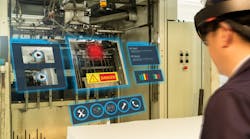Latest from Technology
Sponsored
By Sarah Nicastro, Field Service Evangelist
Although originally seen as a means of survival, Industry 4.0, digital transformation and the introduction of aftermarket services have ensured business continuity for organizations in the current market environment. Organizations that have already embedded digital changes into their operations such as automated production processes, IoT connected teams and data-driven decision-making have been able to stay on top during the coronavirus pandemic.
Munters, a leading supplier of sustainable dehumidifying solutions, is among a number of companies whose pre-existing digital infrastructure and challenger attitude has helped them practice business continuity. After quickly identifying the impact the pandemic could have on operations, Munters looked to augmented reality and remote assistance tools to avoid disruptions in manufacturing & field operations and customer support.
Ensure global disruption doesn’t result in business disruption
Munters manufactures, sells and maintains specialist equipment for demanding industrial sectors where controlling temperature and humidity is mission-critical. With five production units in the United States and over 20 locations worldwide, the company’s business model relies heavily on completing on-site visits—including even before the initial installation of equipment.
To reduce reliance on site visits, the company looked to remote software tools to create functionality enabling teams to interface remotely with customers and improve efficiency by being able to perform remote resolution and diagnosis—a critical step in its journey to servitization.
The company wasted no time when it realized its servitization efforts could be in danger, creating a level of urgency to make remote assistance technology operational in the shortest window of time possible.
Remote customer support – without compromising the quality
Munters’ goals were both to provide remote support to field technicians and to support a new manufacturing production line without sending experts to the site.
IFS Remote Assistance makes it possible for teams to be anywhere, instantly—this includes field technicians and third-line support using the solution on their mobile devices, as well as experts guiding the opening of the new production line using Vuzix smart glasses. It provides opportunities for remote customer support and resolution, remote diagnosis to increase first-time fix rates, better utilization of valuable resources, as well as more rapid employee training and knowledge transfer.
Act fast and reap the rewards
Munters technicians can now take advantage of the features and hands-free collaboration opportunities offered by merged reality environments. This means users can collaborate and interact in real-time while telestrating, freezing images, using hand gestures and even adding real objects into the merged reality environment—whether that’s technician to third-line support, technician to customer, or expert to manufacturing facility.
With modern remote assistance tools, time to value can be rapid and what minimal user training is required is extremely intuitive. In the case of Munters, a pilot was underway in just six days and training took less than two hours. The company was able to extend the solution to more than 200 users globally in just two weeks.
Use today’s solutions as a platform for growth
The example of Munters successfully adapting to unprecedented circumstances demonstrates not only how remote assistance technology can ensure business continuity during a global pandemic, but also the immense potential to further leverage the solution once business returns to a more normal state.
When considering how this technology can modernize operations, the benefits are clear to see. Efficiency gains come from the ability to perform maintenance inspections remotely, improve first-time fix rates as a result of remote diagnosis, reduce the number of technicians sent to sites and provide remote support to manufacturing facilities.
The time is ripe to bring servitization visions to life
The key for businesses now is to identify how the changes they have implemented during the pandemic can be leveraged for long-term business development. After the pandemic, new tools and processes will be fundamental for organizations to unlock the full potential of servitization. Remote assistance and augmented reality tools have been an essential part of business continuity for organizations, but they are also key to finding alternative ways of working with customers in the future.
Munters has used technology not just as a quick fix, but as an opportunity to reimagine how its business could operate going forward. Organizations that follow the same path and use disruption in their business as a platform for growth will see a positive impact far beyond the end of the pandemic.
Sarah Nicastro is a Field Service Evangelist for IFS. She has over a decade of experience covering the trends, technologies and business drivers that most impact end users of field service solutions from her tenure as Editor-in-Chief at Field Technologies Online. During her time at FTO, Sarah’s mission has been to help field service customers tell their stories.


